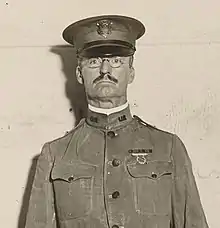Charles Aloysius Hedekin
Charles Aloysius Hedekin (December 9, 1865 – January 30, 1944) was a United States Army Cavalry officer[2] in the late 19th and early 20th centuries. He served in numerous locations and incidents.
Charles Hedekin | |
|---|---|
 Brig. Gen. Charles Hedekin in September 1918 | |
| Born | December 9, 1865 Fort Wayne, Indiana |
| Died | January 30, 1944 (aged 78) Washington, D.C. |
| Allegiance | |
| Service/ | |
| Years of service | 1888–1920 |
| Rank | |
| Service number | 0-13487 |
| Spouse(s) | Adelaide Drew[1] |
| Children | 2 |
Biography
Hedekin was born on December 9, 1865, in Fort Wayne, Indiana. He graduated from the United States Military Academy in 1888.[1]
Hedekin was commissioned into the 3rd Cavalry Regiment. He did frontier duty from his commissioning in 1888 to 1895. He went on detached service with the Intercontinental Railway Commission from March 1891 to May 1892, something which took him through Central America. Hedekin served along the border with Mexico during the Garza Revolution. After serving at the Jefferson Barracks Military Post for three years, he was stationed at Fort Ethan Allen, Fort Sheridan, and Fort Myer. Hedekin was sent to the Philippines, serving there for two years and returning in 1902. He then was sent to Fort Apache, Arizona. He served again in the Philippines from 1906 to 1908 at Fort Stotsenburg. After returning, Hedekin's regiment was stationed at Fort Sam Houston and Fort Clark, Texas.[1]
On his promotion to the rank of major on September 3, 1911, Hedekin was transferred to the 15th Cavalry Regiment, commanding the Second Squadron. He completed a special field officers course at Fort Leavenworth, and then he graduated from the Mounted Service School at Fort Riley. He then graduated from the United States Army War College in 1912. Hedekin was stationed with the Militia Division of the United States Department of War, and he rescued stranded American tourists in Europe from August to October 1914. He went with the 4th Cavalry Regiment to the Schofield Barracks in 1916, and he assumed command of the 13th Cavalry Regiment in Fort Riley in July 1917. Hedekin took the regiment to the border with Mexico, though he was personally recalled to Washington shortly afterward.[1]
Hedekin was promoted to brigadier general on June 26, 1918. He commanded the 155th Depot Brigade along with replacements at Camp Lee. He then commanded the 15th Cavalry Regiment in October 1919, and then the 7th Cavalry Regiment at Fort Bliss. Hedekin retired on August 5, 1920.[1]
In retirement, Hedekin and his family moved to Bethesda, Maryland, living there for seven years.[3] They sold their house in 1930 to go on an extended vacation in Europe, though they had to return to the U.S. in 1931 because hedekin became ill. He was admitted to Walter Reed Army Medical Center for four months, and he and his family left again for Europe afterward, staying until October 1933. Hedekin died in Washington, D.C., on January 30, 1944.[4] He is buried at Arlington National Cemetery.[5]
References
- Davis, Jr. 1998, p. 171.
- "Army Directory" January 1 1918, War Department, page 37
- Davis, Jr. 1998, p. 171–172.
- Davis, Jr. 1998, p. 172.
- "BG Charles Aloysius Hedekin". Find a Grave. Retrieved July 31, 2018.
Bibliography
- Davis, Jr., Henry Blaine (1998). Generals in Khaki. Raleigh, North Carolina: Pentland Press. ISBN 1571970886. OCLC 40298151.CS1 maint: ref=harv (link)
